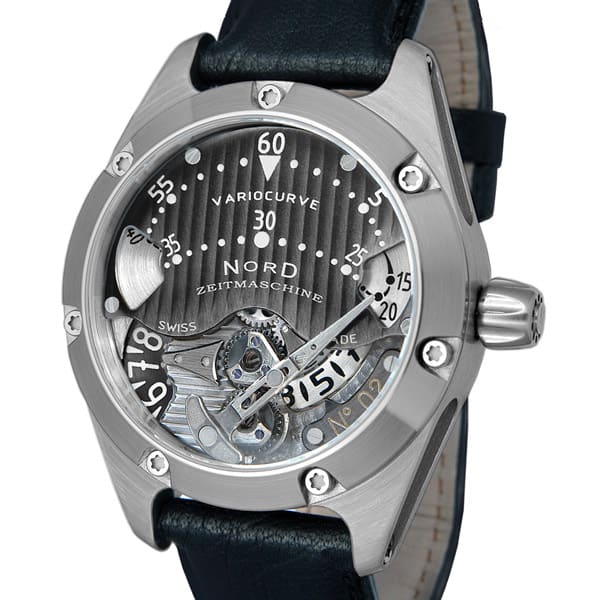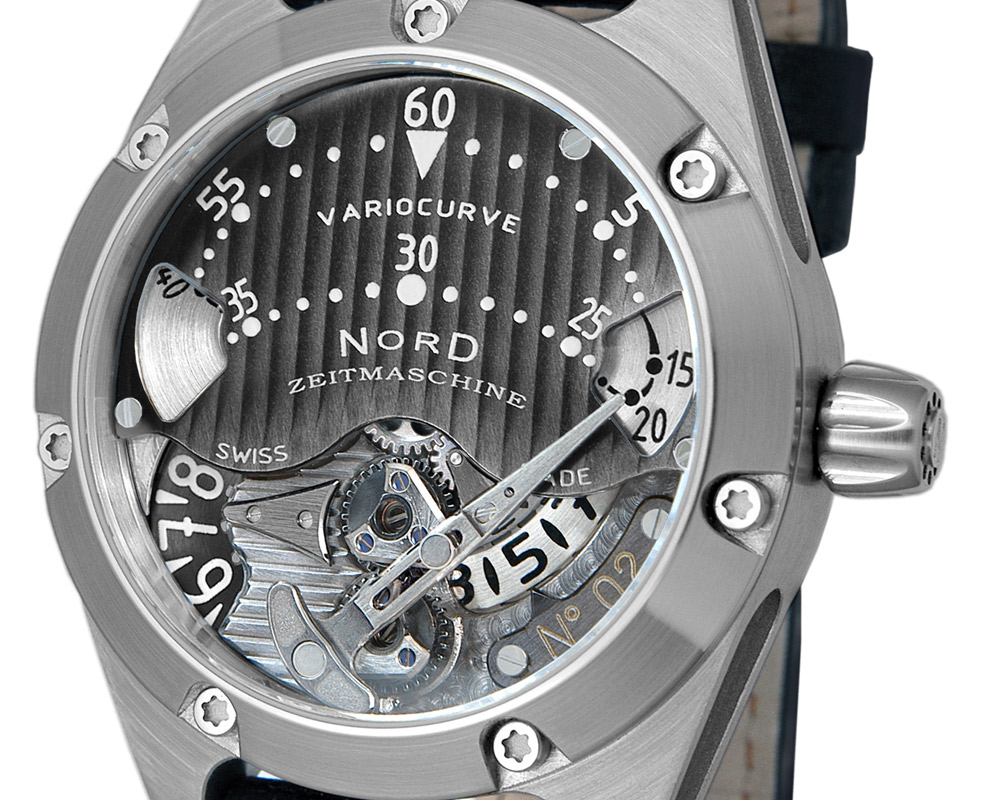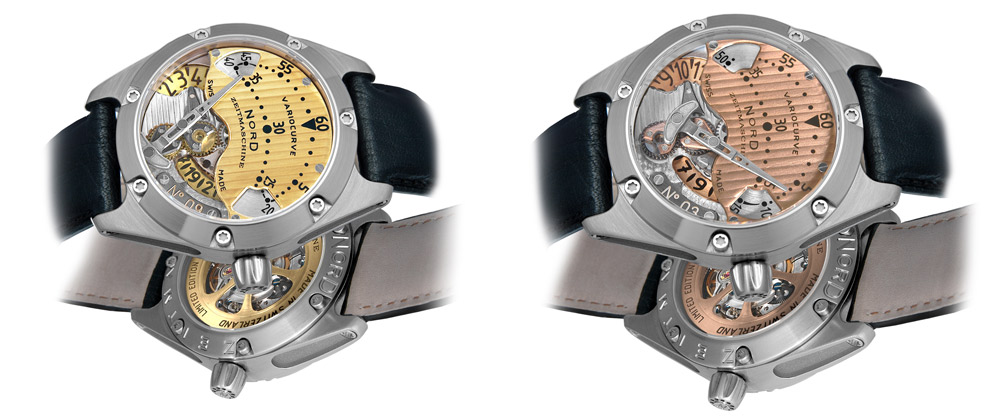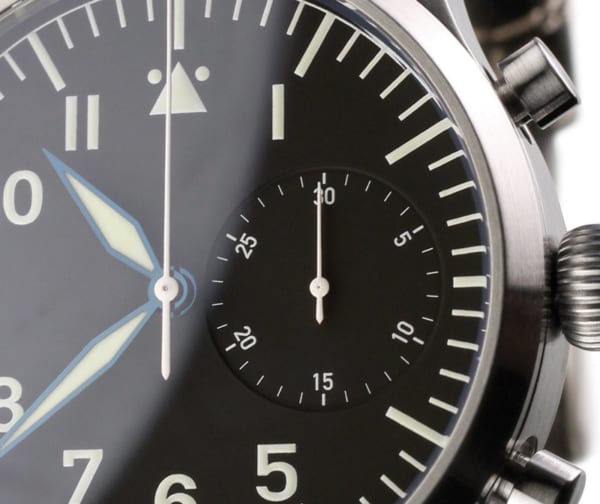Sometimes a watch comes along that at first glance is baffling. Hands aren’t where you expect them to be, indexes are broken or displayed in bizarre ways, there are things moving about that you just have never seen before. Well, I love watches like that; watches that are the mix of genius, creativity and a dose of fun. Brands like Urwerk, Ressence and Harry Winston all come to mind with their wild inventions, reinterpretations of time telling and mechanical achievement. So, when I saw the Variocurve by Nord Zeitmaschine, I knew I needed a deeper look.
 And what I saw was weird. At first glance, the watch doesn’t reveal much, but before I even get to the dial and innovative mechanisms within, just take a look at the machining on the case, crown and buckle. This is a watch with a tremendous amount of detailing… And not high polishing and fancy little touches, but rather cutaways and markings that speak to industrial processes.
And what I saw was weird. At first glance, the watch doesn’t reveal much, but before I even get to the dial and innovative mechanisms within, just take a look at the machining on the case, crown and buckle. This is a watch with a tremendous amount of detailing… And not high polishing and fancy little touches, but rather cutaways and markings that speak to industrial processes.  Large torx screws line the perimeter of the bezel and case back, as well as stud the scooped out lugs. The crown has a tapered shaped with fluted cuts towards its base; it looks both purposeful and alien. The styling of the case is then reflected in the very rugged and thick cut buckle, which is one of the most intense buckles I think I’ve seen.
Large torx screws line the perimeter of the bezel and case back, as well as stud the scooped out lugs. The crown has a tapered shaped with fluted cuts towards its base; it looks both purposeful and alien. The styling of the case is then reflected in the very rugged and thick cut buckle, which is one of the most intense buckles I think I’ve seen.
Looking in now at the dial, one can see it is more of a movement decorated to indicate the time, than a dial over a movement. Plates, screws, disks, apertures, numbers and dots layer on top of each other to create a machine that, like the brand name itself, has a distinctly sci-fi feeling. And truth be told, what you are looking at is at once a dial and a proprietary module designed to create a unique time telling experience. That experience is broken down to 2 primary components: an hour disc and a minute hand. At about 8 o’clock you’ll notice a black disk with white numerals peaking through a semicircular aperture (or black on gold/rose gold, model depending). Next to it there is a large metal arrow that is screwed into a cote de geneve plate that is pointing towards the current hour. Other than the positioning of the disk, a non-jumping hour indicator is not all too uncommon. What is quite uncommon is the motion of the minute hand.
 As you can see in the video above, the minute hand does not rotate about the center of the dial. In fact, it does not really rotate at all. The hand is being moved by two gears, one towards the base of the hand the other towards the center. The gear at the base of the hand is at a fixed pivot point, where as the gear towards the center is at a sliding pivot point. What this does is create a hand with both horizontal and vertical motion, as well as a hand with variable motion. What I mean by that, is that at certain points of its 60-minute journey it is moving more horizontal, and somewhat “faster”, where as at other times it moving more vertical, and “slower”. The minute index underneath is then shaped according to this bizarre pathway, which takes a crescent shape. Now, as though that was not enough unto itself, the inconsistent motion of the hand needs a dynamic portion of the dial to compensate for the change in speed. From the 9th minute to the 23rd and the 37th to the 51st there are two apertures that have rotating disks underneath. These discs contain the missing portions of the index, and as the hand passes over the area these discs move underneath, bringing the minutes to the hand.
As you can see in the video above, the minute hand does not rotate about the center of the dial. In fact, it does not really rotate at all. The hand is being moved by two gears, one towards the base of the hand the other towards the center. The gear at the base of the hand is at a fixed pivot point, where as the gear towards the center is at a sliding pivot point. What this does is create a hand with both horizontal and vertical motion, as well as a hand with variable motion. What I mean by that, is that at certain points of its 60-minute journey it is moving more horizontal, and somewhat “faster”, where as at other times it moving more vertical, and “slower”. The minute index underneath is then shaped according to this bizarre pathway, which takes a crescent shape. Now, as though that was not enough unto itself, the inconsistent motion of the hand needs a dynamic portion of the dial to compensate for the change in speed. From the 9th minute to the 23rd and the 37th to the 51st there are two apertures that have rotating disks underneath. These discs contain the missing portions of the index, and as the hand passes over the area these discs move underneath, bringing the minutes to the hand.
Though this might be a work of unnecessary complexity, the end result is both fascinating and surprisingly cool. And the complexity of the watch is not just in the unique minute display and hour disk layout, but also in the making of the watch. Daniel Nebel, the founder of Nord Zeitmachine and designer/engineer of the watches, creates the components in his own shop, adding a large amount of skilled craftsmanship into the mix. Something else I find quite intriguing is that a basic ETA 2824-2 powers the module he created for the Variocurve. This is the same movement that we’ve seen over and over in budget friendly automatics, and to think that with…well, a lot of ingenuity, one can take that movement and create something totally new is inspiring. Given all that has gone into this timepiece, it is not surprising to see a price tag of 14,000 CHF (about $14560), which is why the Variocurve is perfectly suited for a watch lust.
by Zach Weiss









 Featured Videos
Featured Videos









